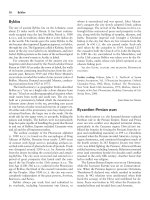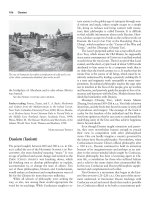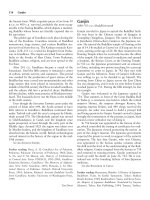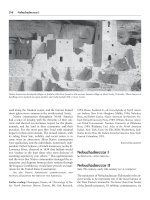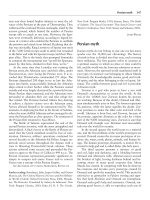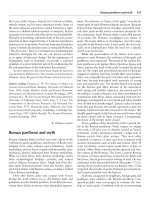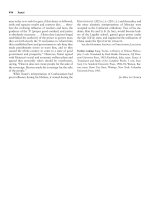Encyclopedia of world history (facts on file library of world history) 7 volume set ( PDFDrive ) 3234
Bạn đang xem bản rút gọn của tài liệu. Xem và tải ngay bản đầy đủ của tài liệu tại đây (64.89 KB, 1 trang )
414
Tlatelolco massacre (1968)
Shastri died the following day of a heart attack. The
main provisions included the withdrawal of all troops to
their prewar positions, the restoration of diplomatic relations, the promise not to intervene in the internal affairs
of the other side, and the agreement to hold discussions
concerning various social and economic issues. The oversight of the withdrawal of forces was conducted by the
United Nations Military Observer Group in India and
Pakistan (UNMOGIP) and the United Nations IndiaPakistan Observation Mission (UNIPOM). These missions were successfully concluded.
The permanent end to war and the renunciation of
terrorist activities in Kashmir were not included in the
final treaty, and both India and Pakistan suffered from
some measure of internal disorder. In the case of Pakistan, unrest forced the resignation of Ayub Khan, the
head of a military government, in 1969. Meanwhile,
Shastri was succeeded by indira gandhi, whose
administration was troubled by right-wing opposition. The two countries were at war again in 1971 as
part of the secession of East Bengal from Pakistan and
the creation of Bangladesh.
See also indo-pakistani war (kashmir).
Further reading: Edwardes, Michael. “Tashkent and After.”
International Affairs 42, no. 3 (July 1996); Schofield, Victoria. Kashmir in Conflict: India, Pakistan and the Unending
War. 2nd rev. ed. I.B. Tauris, 2003; Talbot, Ian. Pakistan: A
Modern History. Palgrave Macmillan, 2005; United Nations.
“United Nations India-Pakistan Observation Mission (UNIPOM)—Background.” />co_mission/unipombackgr.html (cited July 2006).
John Walsh
Tlatelolco massacre (1968)
In one of the most important and controversial episodes
in postwar Mexican history, on October 2, 1968, police
and army units violently suppressed a demonstration
in Tlatelolco Square in the heart of Mexico City. The
government’s version of events differed starkly from
those of eyewitnesses and the version that gained currency among much of the populace. The crackdown
contributed to a growing crisis of legitimacy for the
ruling party, the Partido Revolucionario Institucional
(PRI), fueling popular sentiments that the PRI was corrupt, dictatorial, and antidemocratic, and tarnishing
Mexico’s image on the eve of the country’s hosting of
the 1968 Summer Olympics.
The roots of the October 1968 events in Tlatelolco
have been traced to the upsurge in student and worker
democratic and anti-PRI activism from the late 1950s,
including the Teachers’ Movement in 1958; the Railway Workers’ Movement in 1958–59; demonstrations
in support of the Cuban Revolution (1959); a massive student strike at the National University (UNAM,
spring 1966); and protest movements in the states
of Puebla (1964), Morelia (1966), and Sonora and
Tabasco (1967).
More immediate antecedents include the government’s mobilization of an antiriot paramilitary squad,
the granaderos, in response to street fights between
two Mexico City schools in July 1968, and again in
response to student protests commemorating the anniversary of fidel castro’s 26th of July Movement.
Tensions mounted throughout August as students held
huge demonstrations at the UNAM and the National
Polytechnic Institute.
The events prompted the formation of a National Student Strike Committee, which issued a list of
demands that included disbandment of the granaderos and release of all political prisoners. An estimated
500,000 people, mostly students and workers, participated in antigovernment demonstrations in Mexico
City’s central square (Zócalo) on August 27, to that date
the country’s single largest mass protest. Law enforcement agencies responded with tanks and armored cars,
killing at least one student. In mid-September, President
Gustavo Díaz Ordaz ordered 10,000 army troops to
occupy the UNAM campus. Some 500 protesters were
jailed, and in the ensuing weeks tensions throughout
Mexico City ran high.
The exact sequence of events on the evening of
October 2 in the Plaza de las Tres Culturas (Plaza of
the Three Cultures) in the District of Tlatelolco, where
5,000 to 10,000 protesters had gathered, remains disputed. The next day the government claimed that terrorists had opened fire on the police from a nearby
building and that police had responded to the unprovoked attack. Most newspapers at the time reported
from 20 to 28 protestors killed. Eyewitnesses recalled
with near unanimity that police and army units had
instigated the violence, dropping flares from helicopters before spraying machine-gun and small-arms fire
indiscriminately into the crowd, killing hundreds.
The British newspaper The Guardian estimated
after “careful investigation” that 325 were killed, a figure cited by Mexican writer Octavio Paz as the most
plausible. In the ensuing days and weeks, thousands
were jailed. Memories of Tlatelolco remained fresh into

